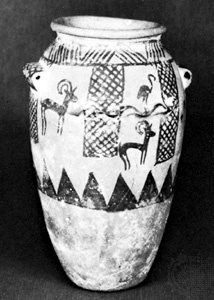Gerzean culture
Egyptian history
also called Naqādah II culture
 predynastic Egyptian (Egypt, ancient) cultural phase given the sequence dates 40–65 by Sir Flinders Petrie (Petrie, Sir Flinders) and later dated c. 3400–c. 3100 BCE. Evidence indicates that the Gerzean culture was a further development of the culture of the Amratian (Amratian culture) period, which immediately preceded the Gerzean. Centred primarily at Naqādah and Hierakonpolis in Upper Egypt, Gerzean culture was contemporary with that at Al-Maʿādī (Maʿādī, Al-) in the north and was characterized by a buff-coloured pottery with pictorial decorations in dark red paint; the use of a tubular drill with abrasive for stonecutting; pear-shaped mace heads; ripple-flaked flint knives; and an advanced metallurgy. Toward the end of the period, pictographic writing on pottery, slate palettes, and stone appeared, under kings employing pharaonic iconography. Contact with western Asia during this time may have inspired the building of mud-brick niched architecture, the use of cylinder seals (cylinder seal), and the adoption of certain ornamental motifs.
predynastic Egyptian (Egypt, ancient) cultural phase given the sequence dates 40–65 by Sir Flinders Petrie (Petrie, Sir Flinders) and later dated c. 3400–c. 3100 BCE. Evidence indicates that the Gerzean culture was a further development of the culture of the Amratian (Amratian culture) period, which immediately preceded the Gerzean. Centred primarily at Naqādah and Hierakonpolis in Upper Egypt, Gerzean culture was contemporary with that at Al-Maʿādī (Maʿādī, Al-) in the north and was characterized by a buff-coloured pottery with pictorial decorations in dark red paint; the use of a tubular drill with abrasive for stonecutting; pear-shaped mace heads; ripple-flaked flint knives; and an advanced metallurgy. Toward the end of the period, pictographic writing on pottery, slate palettes, and stone appeared, under kings employing pharaonic iconography. Contact with western Asia during this time may have inspired the building of mud-brick niched architecture, the use of cylinder seals (cylinder seal), and the adoption of certain ornamental motifs.The Dynastic culture, which immediately followed the Gerzean, developed directly out of the Gerzean and the other Upper Egyptian cultures that preceded it; gradually, during the last part of the Gerzean, the rulers in Hierakonpolis were able to create not only a cultural but also a political unification of all of Egypt, ushering in the successive dynasties of pharaonic Egypt.
- davenport
- Davenport, Charles Benedict
- Davenport, Edward Loomis
- Davenport, Fanny Lily Gypsy
- Davenport, John
- Davenport, Thomas
- Davenport ware
- Daventry
- Daves, Delmer
- Dave Wottle
- David
- David Alfaro Siqueiros
- David al- Mukammas
- David Ames Wells
- David Antin
- David ap Gruffudd
- David Ap Llywelyn
- David Bailey
- David Baltimore
- David Barnard Steinman
- David, Baron Günzburg
- David Beaton
- David Beckham
- David Belasco
- David Ben-Gurion